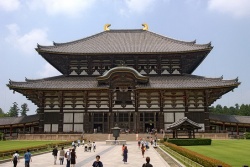Kegon
Kegon (Kanji: 華厳 Hiragana: けごん) is the name of the Japanese transmission of the Huayan school of Chinese Buddhism.
Huayan studies were founded in Japan when, in 736, the scholar-priest Rōben (良辯 or 良弁) originally a monk of the Hossō tradition invited Shinshō (審祥, also in Japanese Shinjō, Chinese Shen-hsiang, Korean Simsang) to give lectures on the Avatamsaka Sutra at Kinshōsen-ji (金鐘山寺, also 金鐘寺 Konshu-ji or Kinshō-ji), the origin of later Tōdai-ji. When the construction of Tōdai-ji was completed, Rōben entered that temple to formally initiate Kegon as a field of study in Japanese Buddhism, and Kegon-shū would become known as one of the Nanto Rikushū (南都六宗), or The Six Buddhist Sects of Nanto (Nara). Rōben's disciple Jitchu continued administration of Tōdai-ji and expanded its prestige through the introduction of imported rituals. Kegon thought would later be popularized by Myōe (明惠), who combined its doctrines with those of Vajrayana and Gyōnen (凝然), and is most responsible for the establishment of the Tōdai-ji lineage of Kegon.
Over time, Kegon incorporated esoteric ritual from Shingon Buddhism, with which it shared a cordial relationship. Its practice continues to this day, and includes a few temples overseas.
